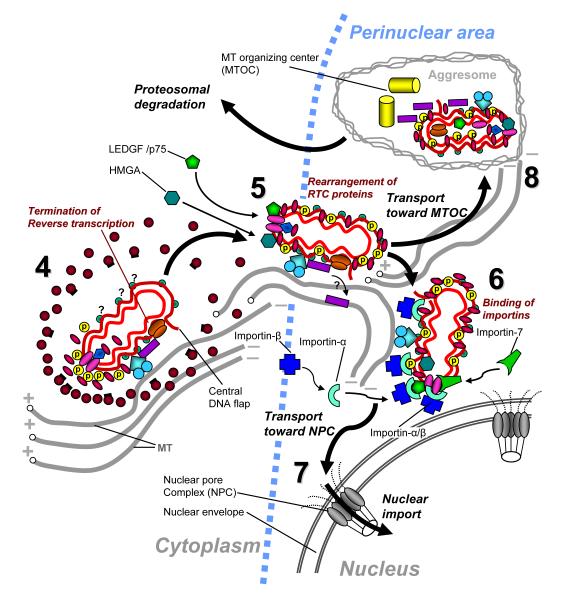Figure 2.
Schematic view of the early phase events involving uncoated HIV-1 RTC. The numbering of events continues from Fig. 1. (4) Completion of reverse transcription results in double-strand cDNA comprising 99-nucleotide-long central DNA flap produced as a result of additional initiation of the (+) DNA synthesis at the second polypurine tract in the middle of the HIV genome. Newly synthesized DNA is probably covered by molecules of nucleocapsid (NC) protein. Progress of reverse transcription is likely associated with progressive capsid disassembly (uncoating). (5) RTCs undergo protein rearrangement which results in binding of MA and Vpr molecules along the length of cDNA. This RTC design protects cDNA from nuclease attack and provides proper exposure of the nuclear localization signals (NLSs) of MA, Vpr and IN to importins. RTC also incorporates host cell proteins: high-mobility group DNA-binding protein, HMGA, and the transcriptional co-activator LEDGF/p75. The latter protein binds IN molecules and contributes to protection of IN from proteolysis and to nuclear targeting of RTC. (6) During their intracytoplasmic transport toward the (−) ends of MT, uncoated RTCs interact with importin (karyopherin) α/β heterodimers which provide translocation of the RTC through the nuclear pore complex (NPC). NLS-comprising proteins of RTC (MA, IN, Vpr and LEDGF/p75) can bind importin α of the α/β heterodimer. IN also binds importin 7, however the role of this interaction in RTC nuclear import is unclear. (7) Cytoplasmic transport of the RTC-importin complexes in the productive pathway ends with interaction with nucleoporins of the NPC and subsequent translocation into the nucleus. (8) Most RTCs traveling to the (−) ends of MT end up in an aggresomal (non-productive) pathway. In this pathway, RTCs are transported on MTs towards the MT organizing center (MTOC) together with aggresomes, which recruit proteasomes. Thus, this pathway results in disposal of RTCs.

